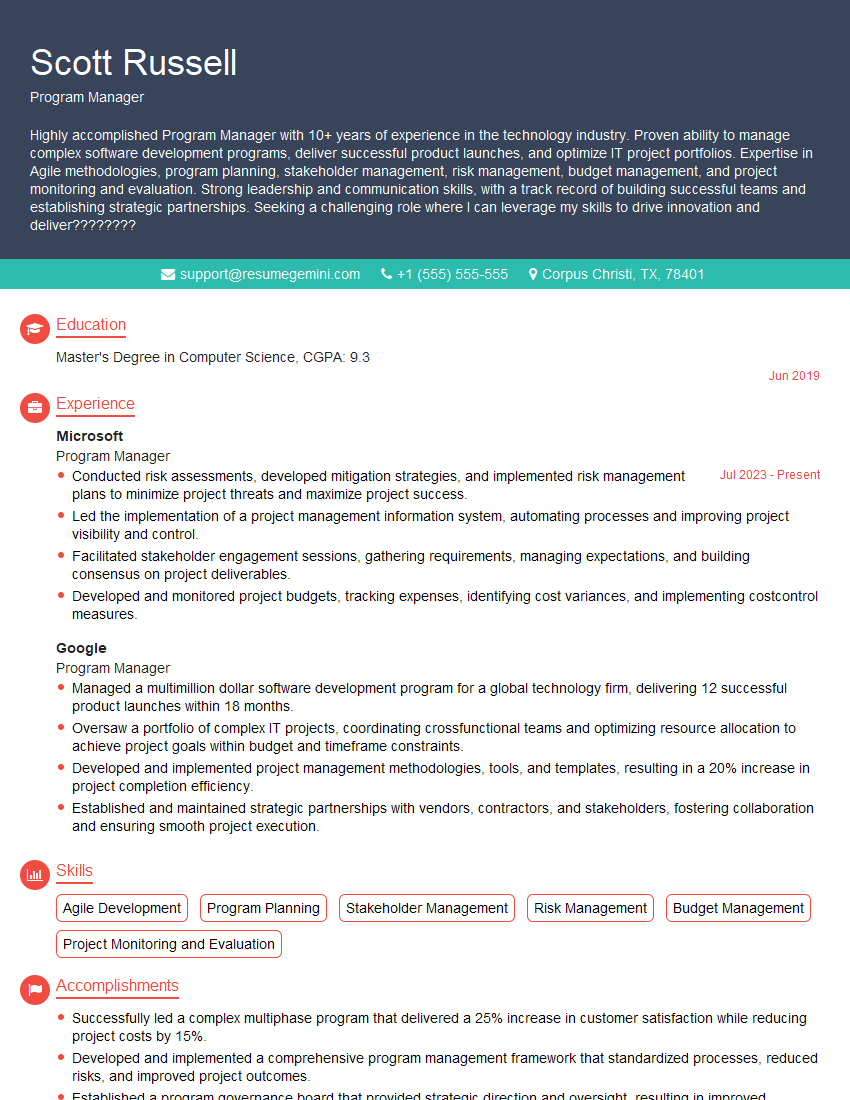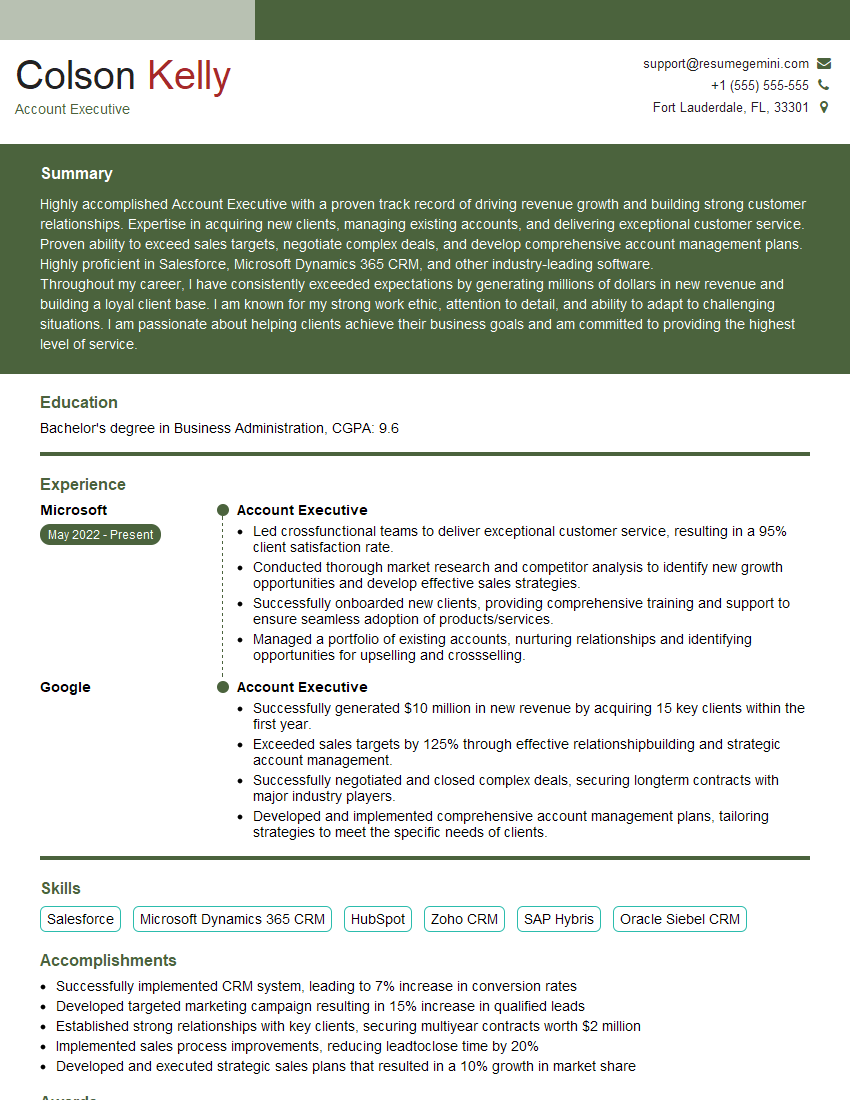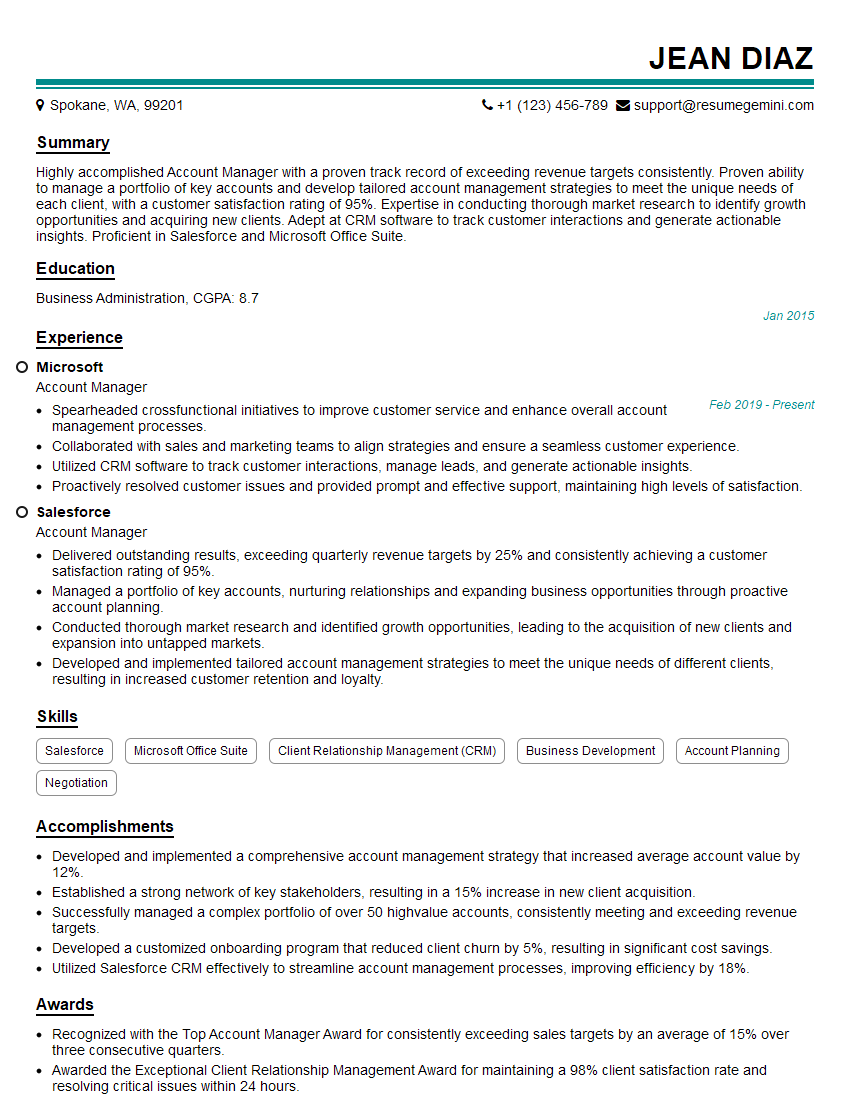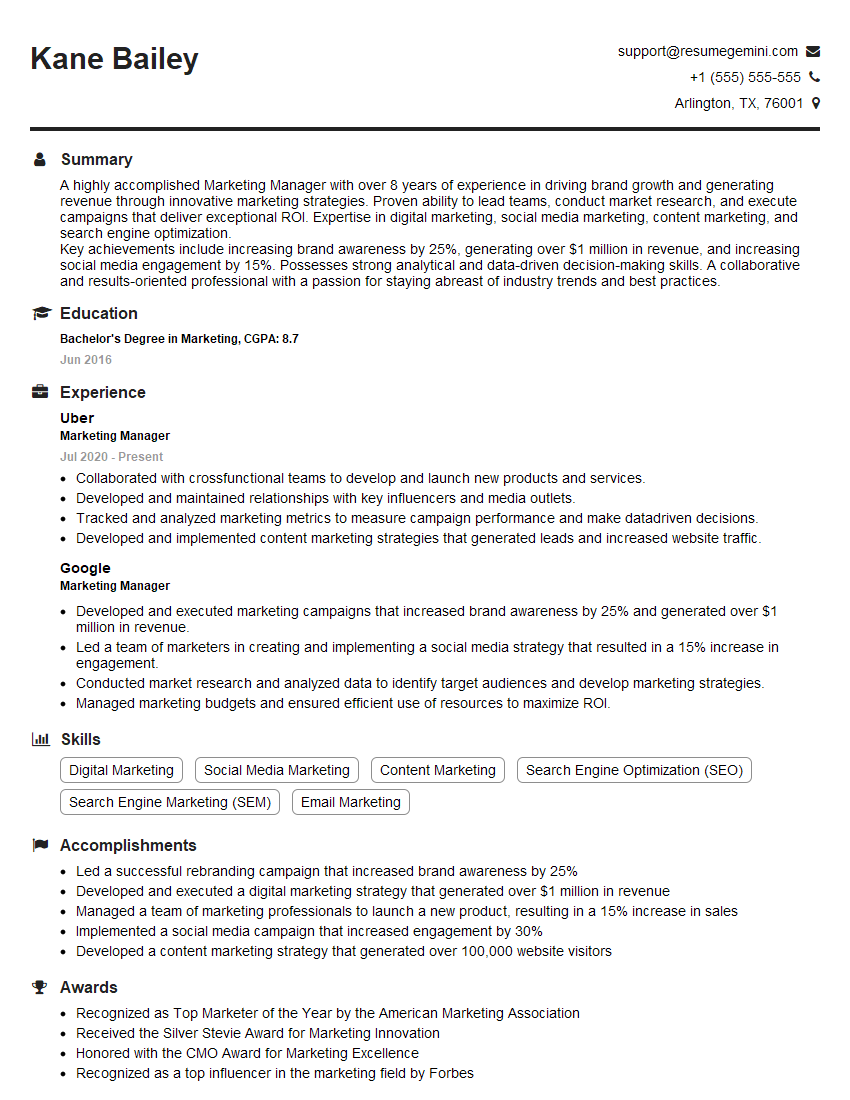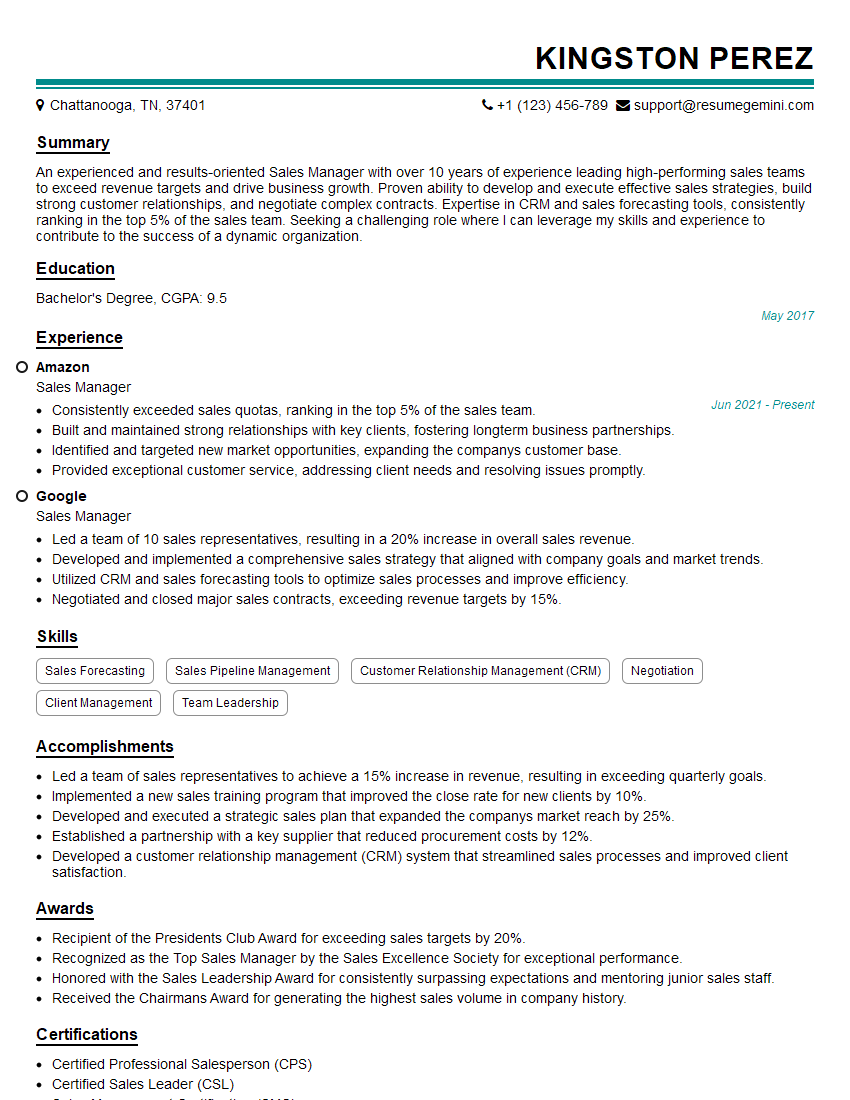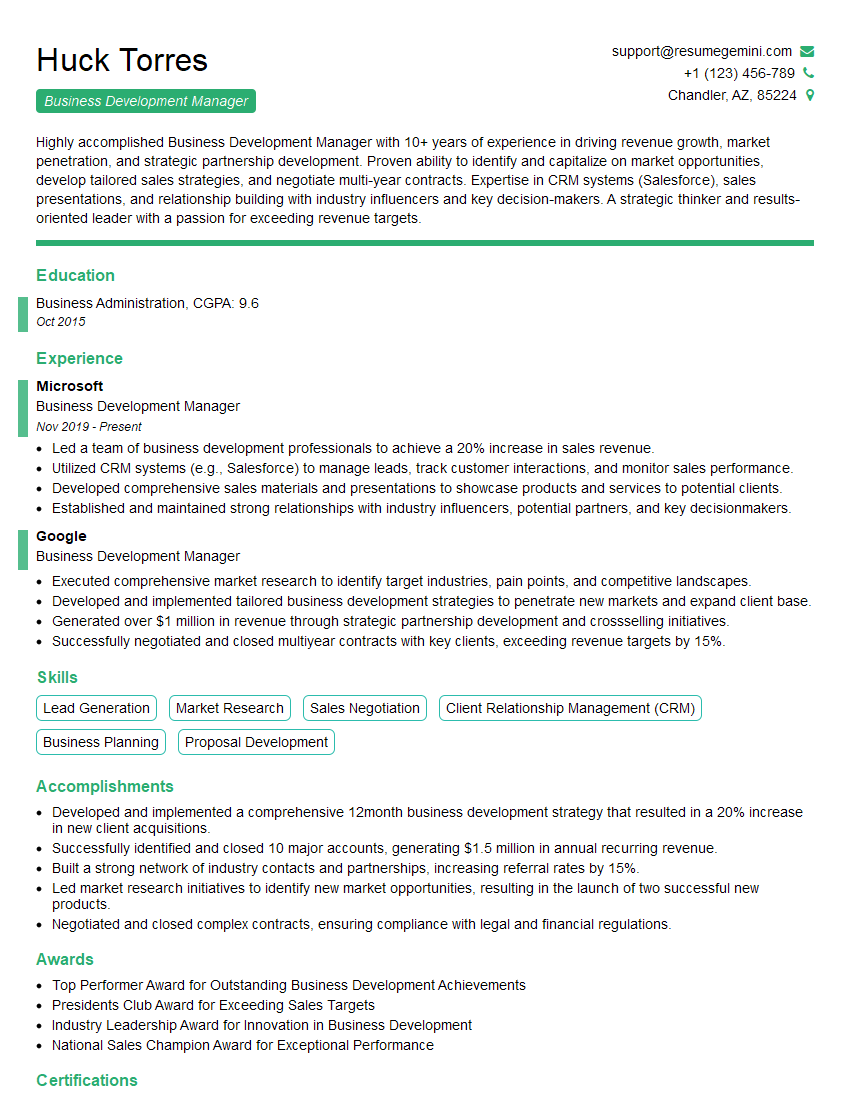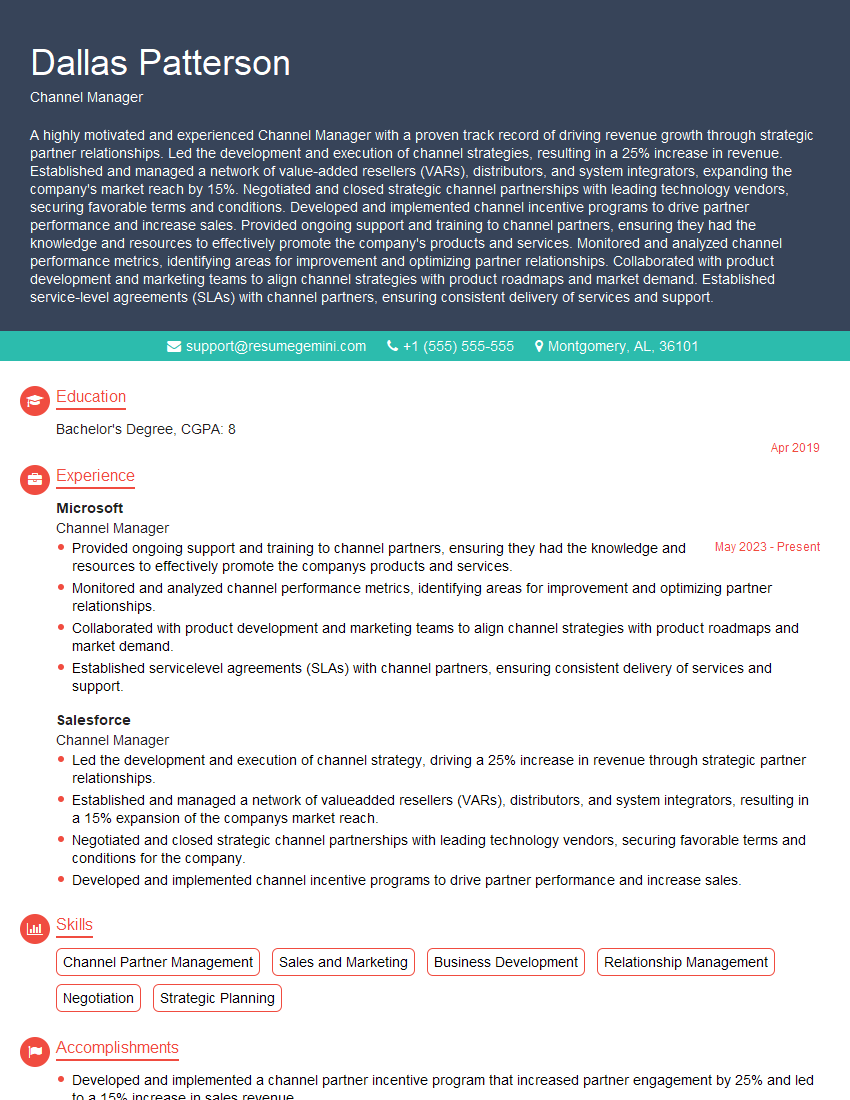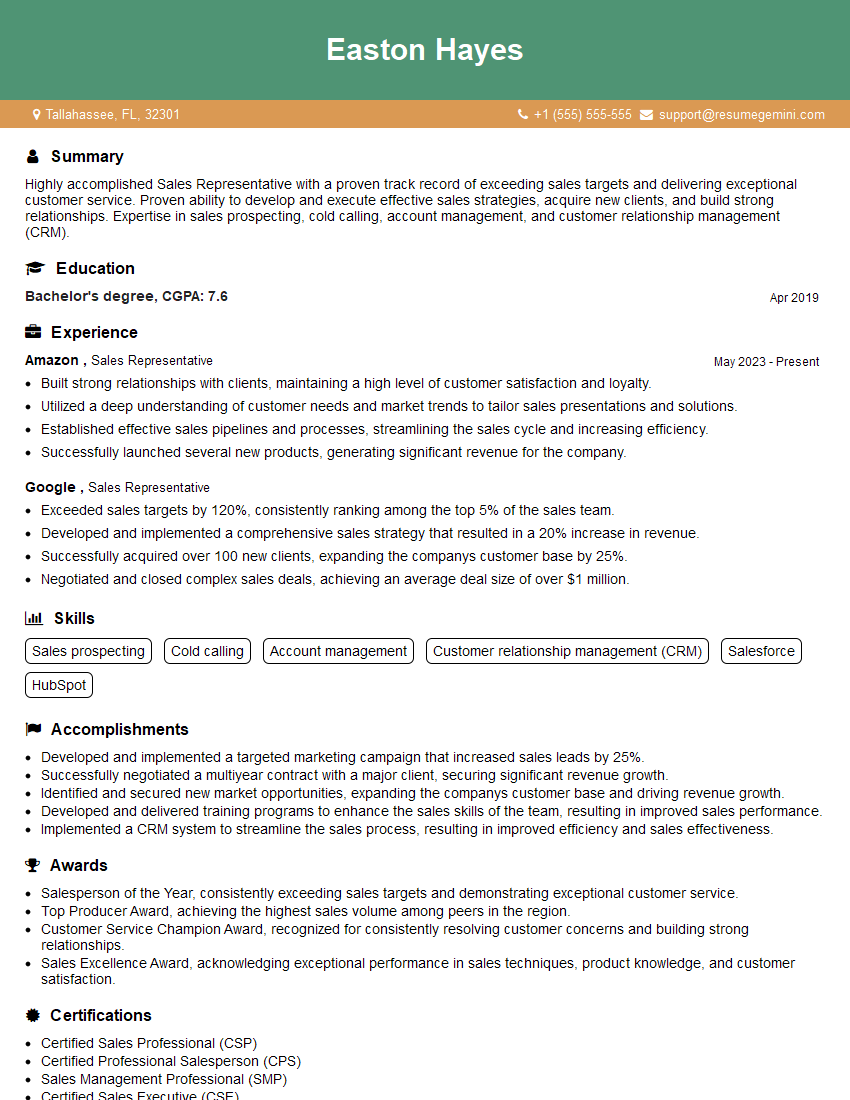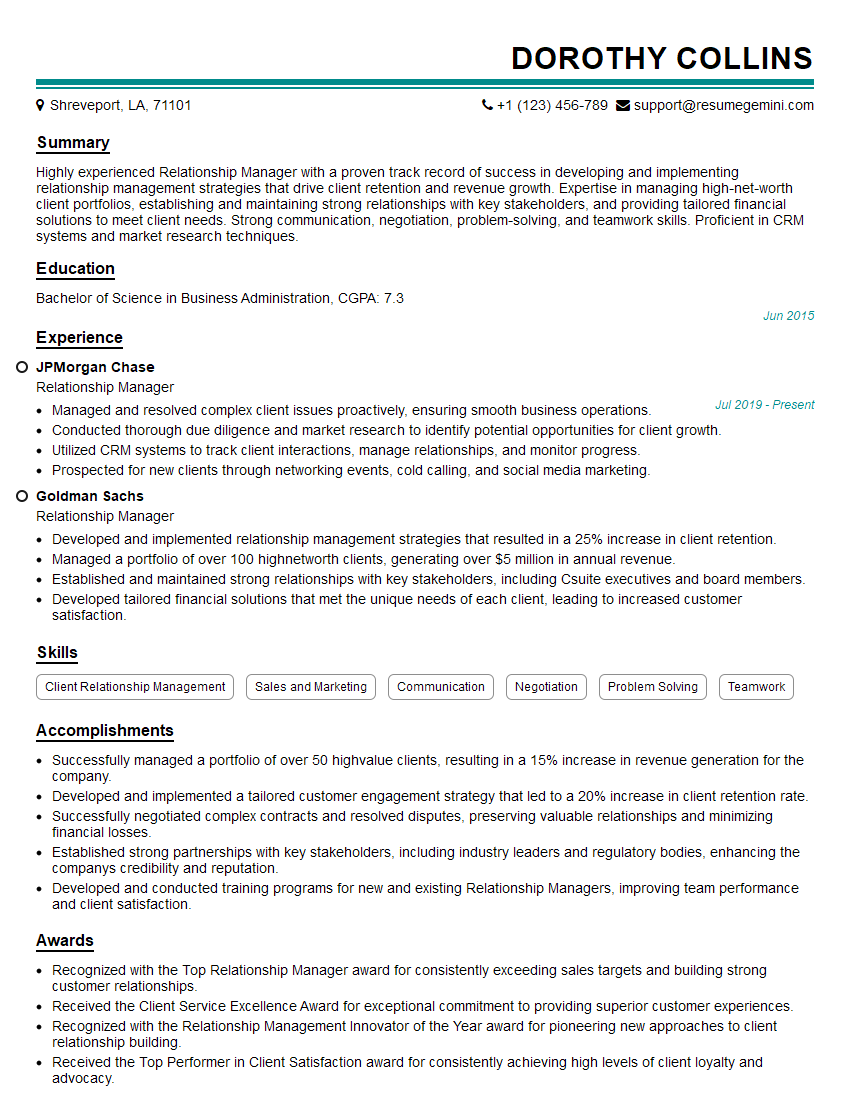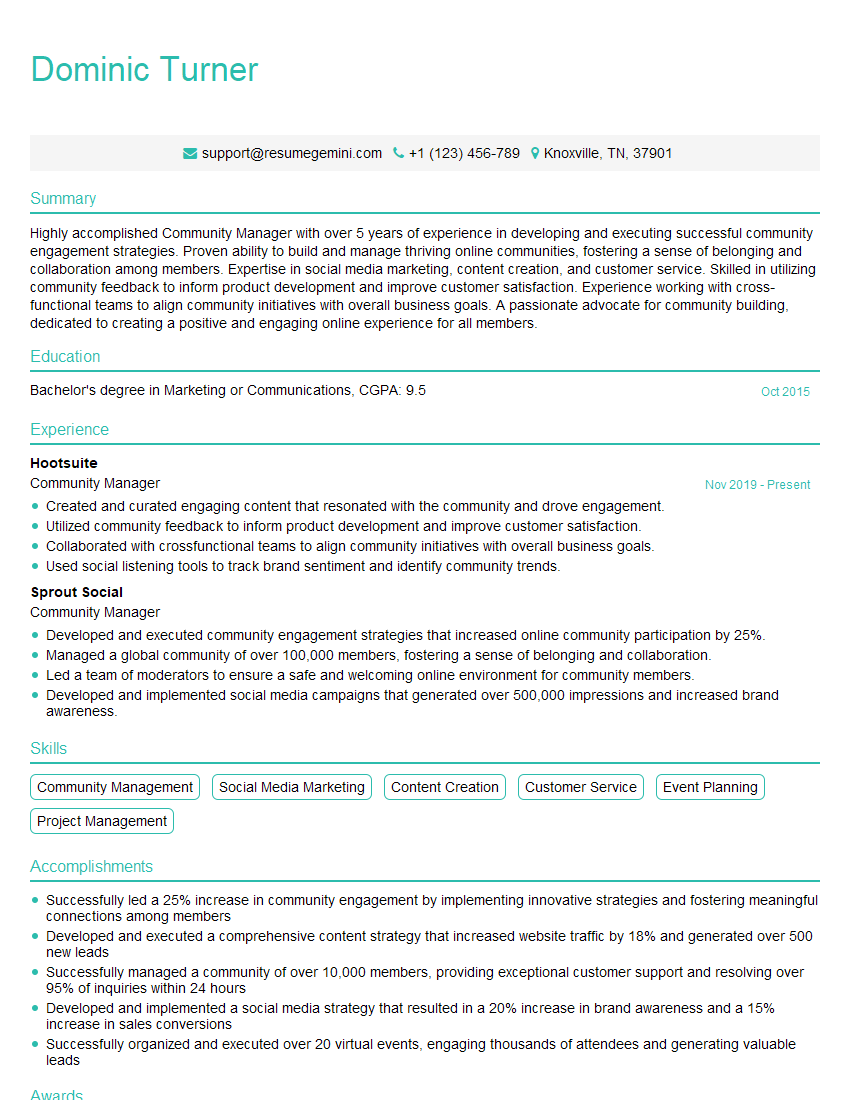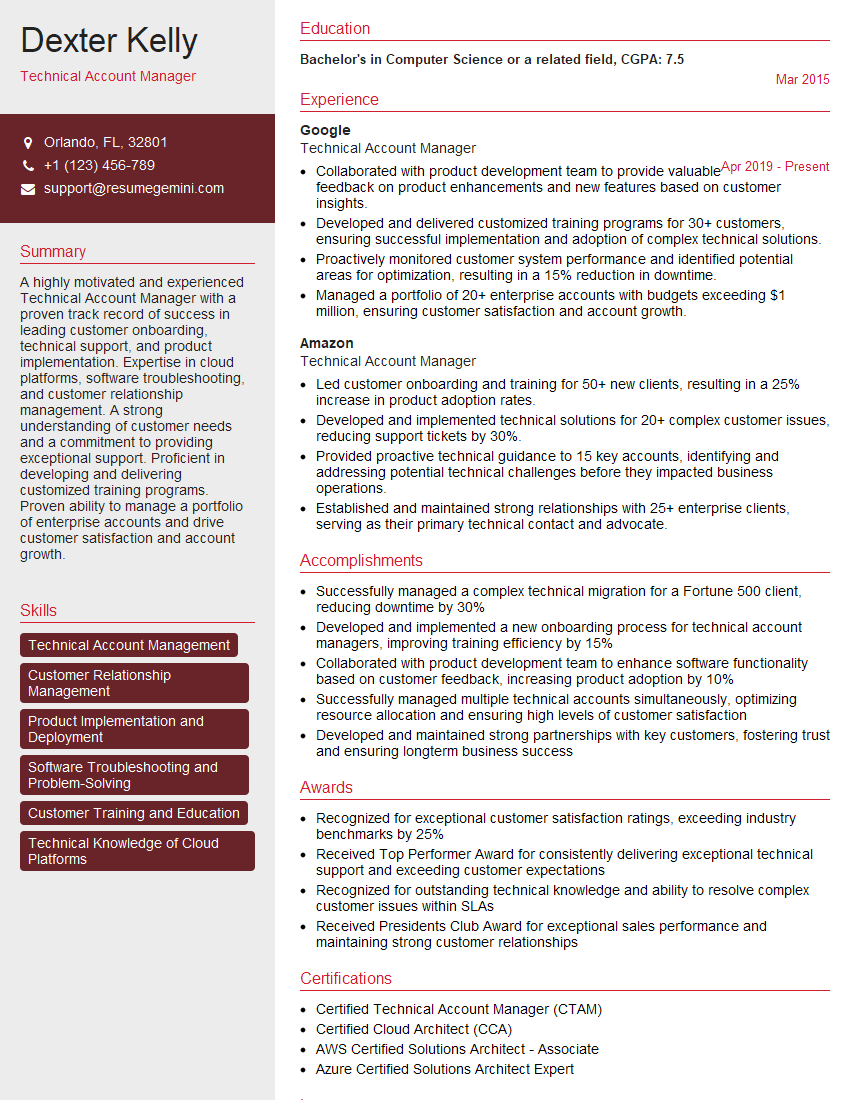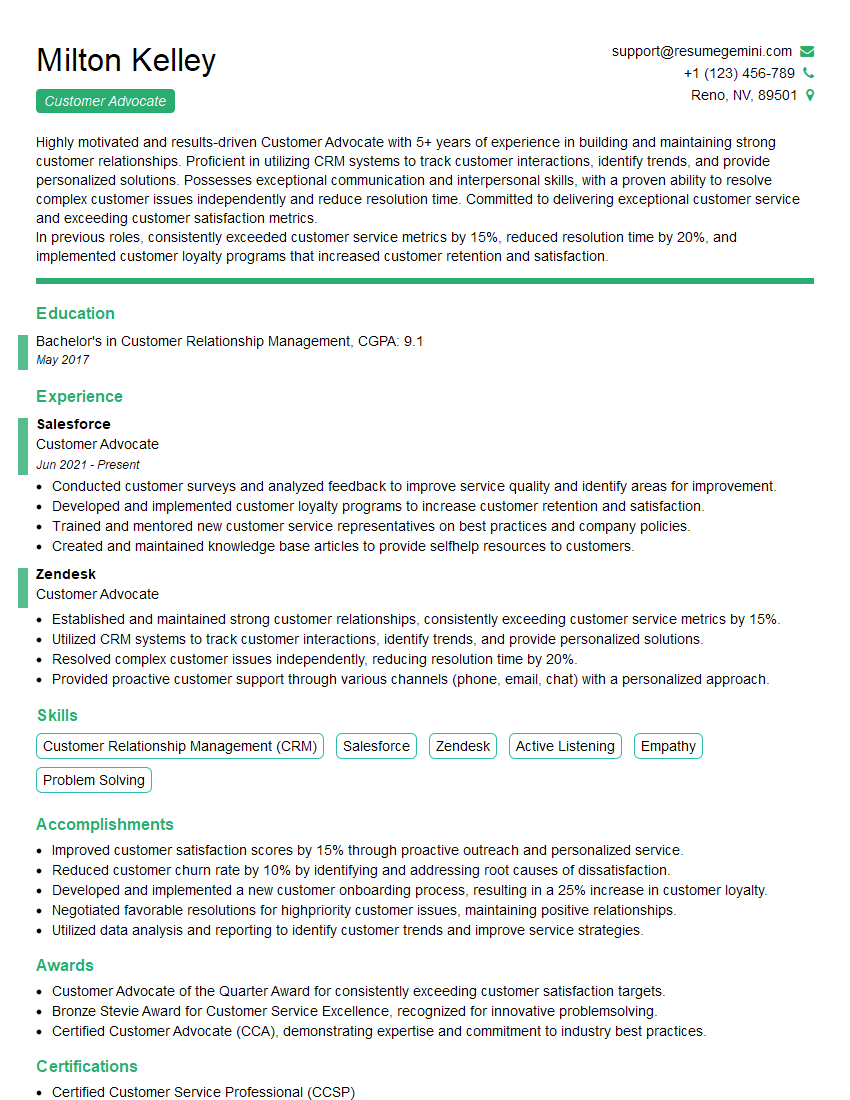Every successful interview starts with knowing what to expect. In this blog, we’ll take you through the top Ability to work with a diverse range of clients interview questions, breaking them down with expert tips to help you deliver impactful answers. Step into your next interview fully prepared and ready to succeed.
Questions Asked in Ability to work with a diverse range of clients Interview
Q 1. Describe your experience working with clients from different cultural backgrounds.
Throughout my career, I’ve had the privilege of working with clients from a wide spectrum of cultural backgrounds, including those from East Asia, South America, and Europe. This exposure has taught me the importance of cultural sensitivity and the power of adapting my approach to resonate effectively with each individual. I find that understanding cultural nuances is paramount; for example, direct communication styles prevalent in some cultures might be perceived as rude or aggressive in others, requiring a more nuanced and indirect approach. I actively seek to learn about the cultural context of my clients, recognizing that understanding their values, communication styles, and expectations is key to building trust and achieving project success.
Q 2. How do you adapt your communication style to suit different client personalities?
Adapting my communication style is crucial to building strong client relationships. I approach this by actively listening and observing the client’s communication style. For example, some clients prefer concise, data-driven communication, while others value a more collaborative, storytelling approach. I adjust my language, tone, and pace accordingly. With clients who are more reserved, I focus on creating a safe and comfortable space for open dialogue. Conversely, with more expressive clients, I ensure my communication is equally engaging and responsive. Essentially, I strive to meet the client where they are and communicate in a way that is both effective and respectful.
Q 3. Give an example of a time you had to navigate a conflict with a client due to cultural differences.
In one project, a disagreement arose between my team and a client from a high-context culture. They felt that our project updates, which were concise and focused solely on the facts, lacked the necessary emotional context. They interpreted this as a lack of care and engagement. We initially misunderstood their concerns, thinking they were simply disagreeing with our progress. However, after taking the time to understand their cultural perspective, we realized the importance of incorporating more relationship-building elements into our communication. We started including informal check-ins, shared project anecdotes and established more personal connections to address their needs and build rapport. This significantly improved the relationship and project outcome.
Q 4. How do you ensure all clients feel valued and respected, regardless of their background?
Ensuring all clients feel valued and respected is fundamental to my approach. I achieve this by actively listening to their perspectives, validating their concerns, and acknowledging their unique experiences. I make a conscious effort to use inclusive language, avoid making assumptions, and consistently demonstrate respect for their time and expertise. Before diving into the specifics of a project, I spend time building personal connections, understanding their personal and professional goals, and actively seeking their feedback throughout the project lifecycle. This creates a sense of partnership and mutual respect.
Q 5. Explain your approach to building rapport with clients from diverse backgrounds.
Building rapport with diverse clients starts with active listening and showing genuine interest in their perspectives. I begin by asking open-ended questions to understand their needs and goals, ensuring I actively listen to their responses without interruption. I pay attention to both verbal and non-verbal cues, tailoring my communication to match their style. Building trust takes time; I foster it by being reliable, transparent, and responsive. A simple act of remembering details about their lives or business demonstrates care and strengthens the relationship. For example, remembering a client’s family interests or their company’s recent achievements showcases genuine interest and fosters a strong connection.
Q 6. Describe a time you had to overcome a language barrier while working with a client.
In a project involving a client in Brazil, a significant language barrier emerged. While I spoke some Portuguese, it wasn’t sufficient for complex technical discussions. We overcame this by using a combination of strategies: we engaged a professional interpreter for crucial meetings, utilized translation software for documents, and ensured all communication materials were readily translated into Portuguese. We also incorporated visuals and diagrams extensively to aid in communication. Additionally, I made sure to learn key phrases and practiced simple conversational Portuguese to demonstrate respect and show initiative in bridging the communication gap. This multi-pronged approach ensured that clear and effective communication was maintained throughout the project.
Q 7. How do you handle clients with varying levels of technical expertise?
Handling clients with varying levels of technical expertise requires adaptability and clear communication. For clients with limited technical knowledge, I avoid jargon and utilize simple, straightforward language and analogies to explain complex concepts. I focus on visual aids, such as diagrams and presentations, to illustrate key ideas and ensure they understand the information clearly. For technically proficient clients, I communicate in a more detailed, technical manner, tailoring the level of detail to match their expertise. The key is to always assess the client’s understanding and adjust my communication accordingly, ensuring that everyone is on the same page regardless of their technical background.
Q 8. How do you manage expectations with clients from different cultural backgrounds who may have different communication styles?
Managing expectations with diverse clients starts with understanding that communication styles vary significantly across cultures. What might be considered direct and efficient in one culture could be perceived as rude or insensitive in another. I employ a proactive, multi-faceted approach:
- Active Listening and Clarification: I prioritize truly understanding a client’s needs, not just their words. This involves asking clarifying questions, paraphrasing to confirm understanding, and being mindful of nonverbal cues. For example, in some cultures, direct eye contact is crucial, while in others, it can be considered disrespectful.
- Cultural Sensitivity Training: I continually update my knowledge of different cultural norms and communication styles. This helps me anticipate potential misunderstandings and adapt my approach accordingly.
- Establishing Clear Communication Protocols: At the beginning of every project, I establish clear expectations for communication frequency, methods (e.g., email, video conferencing, phone calls), and response times, ensuring these are tailored to the client’s preferences and technological capabilities. For instance, some clients might prefer detailed email updates, while others might prefer quick, concise phone calls.
- Patience and Empathy: Building trust and rapport takes time, especially with clients from vastly different backgrounds. I demonstrate patience, actively listen to concerns, and show empathy for any cultural differences that might arise.
By consistently applying these strategies, I ensure that client expectations are managed effectively, leading to stronger working relationships and project success.
Q 9. How do you identify and address potential biases in your interactions with clients?
Identifying and addressing biases is crucial for providing equitable and effective service to all clients. My approach is three-pronged:
- Self-Reflection: I regularly reflect on my own biases and assumptions. This includes acknowledging unconscious biases that might influence my perceptions or judgments. I actively seek feedback from colleagues to identify blind spots.
- Active Observation and Data Analysis: During interactions with clients, I pay close attention to my own responses and those of my team. If I notice patterns suggesting bias, I investigate further. This might involve analyzing client feedback, project outcomes, or internal performance reviews.
- Implementation of Fair and Objective Processes: I implement clearly defined and transparent processes for all client interactions, from project proposals to dispute resolution. This minimizes the impact of personal biases by focusing on objective criteria and data-driven decision-making.
For example, if I notice I’m consistently providing less support to clients from a particular background, I actively address this. I might involve a colleague to review the situation or seek training to improve my cultural competency.
Q 10. Describe a time you had to negotiate with a client who had different priorities than your team.
In one project, our team prioritized delivering a high-quality product on time, adhering to strict development standards. The client, however, prioritized rapid deployment to capture a fleeting market opportunity. This conflict threatened the project’s success.
To negotiate, I employed a collaborative approach:
- Understanding Priorities: I spent time understanding the client’s urgency and the potential consequences of a delayed launch. I also clearly explained our team’s concerns regarding quality and long-term maintainability.
- Finding Common Ground: We identified a compromise: a phased rollout, deploying a minimum viable product initially, followed by iterative improvements. This allowed the client to enter the market quickly while ensuring we met our quality standards.
- Transparent Communication: Throughout the process, I maintained open and honest communication with the client, keeping them informed of progress, challenges, and the rationale behind our decisions.
- Documentation and Agreement: We documented the revised project plan, including the phased rollout and revised deadlines, ensuring both parties had a clear understanding and agreement on the terms.
This negotiation fostered a stronger client relationship, as we demonstrated a willingness to accommodate their needs while maintaining our commitment to quality.
Q 11. How do you ensure client confidentiality across different teams and departments?
Maintaining client confidentiality is paramount. We implement a multi-layered approach:
- Data Encryption: All client data is encrypted both in transit and at rest using industry-standard encryption protocols.
- Access Control: We employ strict access controls, limiting access to client data only to authorized personnel on a need-to-know basis. Access is granted and revoked based on roles and responsibilities.
- Data Security Policies: Clear and comprehensive data security policies are in place, covering data handling, storage, access, and disposal. All team members receive mandatory training on these policies.
- Regular Audits: Regular security audits and penetration testing are performed to identify and address vulnerabilities.
- Non-Disclosure Agreements (NDAs): NDAs are signed with all clients and employees to legally protect confidential information.
This holistic approach ensures client confidentiality is maintained across all teams and departments, minimizing the risk of data breaches and protecting sensitive client information.
Q 12. Describe your experience using technology to bridge communication gaps with international clients.
Technology plays a critical role in bridging communication gaps with international clients. My experience encompasses several key areas:
- Video Conferencing: Tools like Zoom and Google Meet facilitate real-time interaction, allowing for richer communication than email alone. This is particularly helpful for complex discussions or when building rapport.
- Project Management Software: Platforms like Asana or Jira provide central hubs for project updates, task assignments, and document sharing, ensuring everyone stays informed regardless of geographical location.
- Translation and Interpretation Services: For clients who don’t speak the same language, professional translation and interpretation services are invaluable for clear and accurate communication. This ensures that there’s no loss of meaning or nuance.
- Time Zone Management: We carefully consider time zone differences when scheduling meetings and setting deadlines to ensure accessibility for all stakeholders.
For instance, in a project with a client in Japan, we used a combination of video conferencing, a shared project management platform, and professional translation services to facilitate seamless communication and collaboration across the time difference. This technology-driven approach ensured efficient project execution and fostered a strong working relationship.
Q 13. How do you prioritize tasks when working with multiple clients with competing deadlines?
Prioritizing tasks with multiple clients and competing deadlines requires a structured approach. I utilize a combination of techniques:
- Prioritization Matrix: I use a matrix (such as Eisenhower Matrix – Urgent/Important) to categorize tasks based on urgency and importance. This helps me focus on high-impact activities first.
- Client Communication: Open and honest communication with clients is essential. I proactively discuss deadlines and priorities, ensuring realistic expectations are set. This might involve adjusting timelines or re-prioritizing tasks in agreement with the client.
- Project Management Tools: Project management software helps visualize tasks, deadlines, and dependencies. This provides a clear overview, facilitating efficient task allocation and tracking progress.
- Time Blocking: I allocate specific time blocks for different projects and clients, minimizing context switching and maximizing focus. This improves efficiency and reduces the risk of missing deadlines.
For example, if Client A’s deadline is imminent and critically important, I might temporarily shift focus from other less urgent tasks to ensure its timely completion, while keeping Client B informed about the temporary shift in priorities.
Q 14. How do you effectively delegate tasks to your team when working on projects with diverse client needs?
Effective delegation when working with diverse client needs involves careful consideration of team members’ skills and client requirements:
- Understanding Team Member Strengths: I ensure a deep understanding of each team member’s skills, experience, and preferred working style. This facilitates optimal task assignment based on individual capabilities.
- Clear Task Definition: When delegating, I provide clear, concise instructions and expectations, including desired outcomes, timelines, and relevant resources. I also clearly communicate the client’s specific needs and preferences.
- Regular Check-ins and Feedback: I schedule regular check-ins to monitor progress, address challenges, and provide constructive feedback. This ensures tasks are completed effectively and efficiently, meeting client expectations.
- Empowerment and Support: I empower team members to take ownership of their tasks and provide the necessary support and resources for successful completion. This fosters a collaborative environment and promotes individual growth.
For instance, when working on a project with a client requiring expertise in a specific niche, I would assign the task to the team member with the most relevant knowledge and experience. I would then provide clear guidelines, establish regular communication channels, and offer support as needed, ensuring client satisfaction and team effectiveness.
Q 15. How do you handle difficult or demanding clients, regardless of background?
Handling demanding clients starts with active listening and empathy. I focus on understanding their needs and concerns, regardless of their background or communication style. I approach every interaction with a genuine desire to find a mutually beneficial solution. This often involves clarifying expectations, setting realistic timelines, and proactively addressing potential roadblocks. For example, if a client is expressing frustration about a delay, I don’t immediately get defensive. Instead, I acknowledge their feelings, explain the cause of the delay transparently, and present options to mitigate the impact. I might offer expedited service on a portion of the project, or suggest alternative solutions to meet their immediate needs.
Furthermore, I firmly believe in setting clear boundaries. While I aim to be flexible and accommodating, I also ensure the client understands my limitations and the parameters of our agreement. This helps prevent misunderstandings and protects me from burnout. Maintaining a professional yet approachable demeanor is key – treating each client with respect and dignity, even when faced with challenging behavior.
Career Expert Tips:
- Ace those interviews! Prepare effectively by reviewing the Top 50 Most Common Interview Questions on ResumeGemini.
- Navigate your job search with confidence! Explore a wide range of Career Tips on ResumeGemini. Learn about common challenges and recommendations to overcome them.
- Craft the perfect resume! Master the Art of Resume Writing with ResumeGemini’s guide. Showcase your unique qualifications and achievements effectively.
- Don’t miss out on holiday savings! Build your dream resume with ResumeGemini’s ATS optimized templates.
Q 16. How do you use feedback from diverse clients to improve your services?
Feedback, especially from diverse clients, is invaluable for service improvement. I actively solicit feedback through surveys, informal conversations, and formal post-project reviews. I analyze this feedback, looking for recurring themes or patterns. For instance, if several clients from a particular cultural background mention a preference for a more formal communication style, I adjust my approach accordingly. I might opt for more structured email updates, or schedule more formal meetings.
Furthermore, I segment feedback by client demographics (where appropriate and ethically permissible) to pinpoint areas needing refinement. I use this data to refine processes, improve communication strategies, and enhance the overall client experience. This iterative approach ensures continuous improvement and allows me to better serve the diverse needs of my clientele.
Q 17. How do you maintain professionalism when faced with challenging client interactions?
Maintaining professionalism during challenging interactions relies heavily on emotional intelligence and effective communication techniques. I remain calm and respectful, even when faced with aggression or frustration. I avoid getting into arguments and instead focus on de-escalation. This involves active listening, acknowledging their feelings, and reframing the conversation towards finding a resolution. For example, if a client raises their voice, I might say something like, “I understand your frustration, and I want to help resolve this. Let’s take a moment to calmly discuss the issue.”
I also utilize written communication to clarify complex issues and prevent misinterpretations. A well-written email can help to document the discussion and provide a space for thoughtful responses, without the immediate pressure of a live conversation. Finally, I have a clear policy for handling abusive or disrespectful behavior, ensuring both my safety and the preservation of professional standards. If needed, I don’t hesitate to involve appropriate managerial support.
Q 18. How do you adapt your project management style based on different client preferences?
Adapting my project management style depends on understanding the client’s preferences and working style. Some clients prefer detailed, structured plans with regular check-ins, while others value autonomy and less frequent communication. I assess each client’s needs early in the process. I do this through initial consultations, questionnaires, or simply observing their communication style. This information guides my approach to task assignment, reporting frequency, and meeting structures.
For example, a client who values a hands-off approach might receive weekly progress reports and only engage in monthly check-in calls. In contrast, a client desiring more direct involvement may benefit from daily stand-up meetings and frequent project updates. My adaptability allows me to provide a tailored experience that maximizes client satisfaction and project success, regardless of their preferences.
Q 19. How familiar are you with different cultural etiquette protocols?
My familiarity with cultural etiquette protocols is extensive. I’ve studied various cultural norms, including communication styles, business practices, and social customs across numerous regions and countries. My understanding extends beyond simple awareness; I strive to apply this knowledge in a respectful and sensitive manner. This includes recognizing variations in non-verbal communication, such as personal space, eye contact, and body language.
I recognize that generalizations about entire cultures can be inaccurate and potentially harmful. I aim to approach each interaction with an open mind, recognizing that individual differences within a culture are vast. I prioritize active listening and observation to tailor my approach to individual clients rather than relying solely on broad cultural generalizations.
Q 20. What resources have you utilized to improve your understanding of cultural diversity?
I’ve utilized several resources to expand my understanding of cultural diversity. This includes online courses on intercultural communication, books and articles on cross-cultural psychology, and attending workshops on cultural sensitivity. I also actively seek opportunities to engage with people from diverse backgrounds, both professionally and personally. These experiences provide invaluable real-world context and insights that complement my formal learning. I find that engaging with diverse communities, observing their interactions, and learning from their perspectives significantly enhances my ability to understand and appreciate cultural nuances.
Q 21. Describe a situation where a misunderstanding arose due to cultural differences. How did you resolve it?
In one project, a misunderstanding arose due to differing communication styles. A client from a high-context culture (where implicit communication is common) expected me to anticipate their needs and adapt the project accordingly, without explicit instructions. As someone accustomed to a low-context culture (where clear, explicit communication is preferred), I initially missed some unspoken expectations. This resulted in a minor delay and some initial client frustration.
To resolve the situation, I initiated a direct conversation to clarify expectations. I actively listened to their concerns, acknowledged their perspective, and explained my approach. I also adjusted my communication to incorporate more implicit cues and anticipatory problem-solving. Ultimately, we established a stronger working relationship built on mutual understanding and clear communication, highlighting the importance of bridging cultural gaps through open dialogue and adapting my approach based on individual client preferences.
Q 22. How do you leverage diversity within your team to better serve diverse clients?
Leveraging diversity within a team to better serve diverse clients is about creating a synergistic environment where different perspectives enrich both internal processes and client interactions. It’s not just about representation; it’s about actively utilizing diverse backgrounds, experiences, and skill sets to understand and meet client needs effectively.
- Understanding Cultural Nuances: Team members with diverse backgrounds bring inherent understanding of various cultural norms, communication styles, and business practices. This allows for more effective tailoring of services and communications to resonate with specific client groups.
- Creative Problem-Solving: A diverse team brings a wider range of approaches to problem-solving. When faced with a challenging client situation, different perspectives can lead to more innovative and effective solutions.
- Building Trust and Rapport: Clients from diverse backgrounds feel more comfortable and understood when interacting with someone who shares a similar cultural background or experience. This builds trust and strengthens relationships, ultimately leading to better outcomes.
- Enhanced Communication: A team that represents a variety of linguistic and communication styles can better anticipate and address communication barriers. This helps to prevent misunderstandings and ensures clear, effective communication with clients from around the world.
For example, in a marketing campaign targeting a Hispanic community, having team members fluent in Spanish and familiar with cultural sensitivities is invaluable to creating authentic and effective messaging.
Q 23. Have you ever had to adapt your business practices to cater to the specific needs of a particular cultural group?
Yes, I’ve adapted business practices to cater to the needs of various cultural groups. One notable instance involved working with a client in Japan. Japanese business culture emphasizes formality, indirect communication, and long-term relationship building.
To adapt, we adopted a more formal communication style, ensuring meticulous attention to detail in proposals and contracts. We also prioritized building a personal relationship with our client counterparts, focusing on trust and mutual respect, even though the project timeline was shorter than we normally undertake. This involved regular face-to-face meetings and more frequent, less formal communication checks.
This approach, though requiring extra effort, led to a very successful project and a strong ongoing business relationship. We learned that prioritizing their preferred communication style and relationship building greatly influenced the overall success.
Q 24. How do you ensure inclusive language and communication in your interactions with clients?
Inclusive language and communication are paramount. It’s about ensuring all clients feel respected, valued, and understood, regardless of their background. This involves conscious effort in several areas:
- Avoiding Gendered or Biased Language: Instead of using generic terms like ‘manpower’ or ‘chairman,’ I use inclusive alternatives like ‘workforce’ or ‘chairperson’.
- Being Mindful of Pronouns: Always confirm preferred pronouns and use them consistently. Asking ‘What are your preferred pronouns?’ creates a positive and inclusive environment.
- Using Clear and Simple Language: Avoid jargon or technical terms that might be confusing or exclusionary to clients with differing levels of professional knowledge or language proficiency.
- Active Listening and Cultural Sensitivity: Pay attention not just to what clients say, but also how they say it. Body language and tone of voice provide important contextual clues.
- Culturally Appropriate Materials: Ensure all marketing materials and communications are visually and linguistically appropriate for the target audience. Consider images and colour palettes that resonate with the cultural group.
For instance, a simple change like using ‘they/them’ as a singular pronoun when unsure of a client’s gender is a demonstrable commitment to inclusion.
Q 25. How do you approach conflict resolution when working with clients from different backgrounds?
Conflict resolution with diverse clients requires empathy, patience, and a deep understanding of cultural differences. My approach involves:
- Active Listening and Clarification: I begin by actively listening to all parties involved, ensuring I understand their perspectives fully before attempting to mediate.
- Identifying Root Causes: I try to identify the underlying causes of the conflict, recognizing that cultural differences might play a significant role. Misunderstandings due to differing communication styles or expectations are common.
- Neutral Facilitation: I act as a neutral facilitator, guiding the discussion towards a mutually acceptable solution rather than imposing my own opinions.
- Cultural Sensitivity: I am mindful of cultural norms and communication styles when communicating with each party. I may need to adjust my communication style to resonate with the cultural background of each individual.
- Seeking Mediation if Necessary: If the conflict proves difficult to resolve internally, I would consider using a qualified mediator with experience in cross-cultural conflict resolution.
A recent example involved a disagreement about project deadlines between a client from a very time-conscious culture and a team member with a more flexible approach. By carefully understanding each perspective and finding common ground, we were able to adjust the timeline to accommodate both needs, ultimately preventing the conflict from escalating.
Q 26. Describe a successful outcome you achieved by effectively managing diverse client needs.
One successful outcome involved a large-scale project with clients from various countries—the US, Japan, and Brazil. The project involved complex technical solutions and required close collaboration across different time zones and cultural backgrounds.
Our success stemmed from proactive communication planning, a well-defined project management system, and deliberate team building. We held regular virtual meetings, incorporating diverse communication styles (e.g., concise emails for the Japanese client, detailed reports for the US client, and more informal video calls for the Brazilian client) and ensured the project reflected all clients’ needs. We also proactively addressed any potential cultural misunderstandings, celebrating differences and using them to strengthen the project outcome. The project was completed on time and within budget, exceeding client expectations and resulting in strong ongoing relationships.
Q 27. How do you proactively identify and mitigate potential cultural misunderstandings with clients?
Proactively identifying and mitigating potential cultural misunderstandings requires cultural intelligence. This means developing a keen awareness of cultural differences and how they might impact interactions with clients.
- Pre-Engagement Research: Before engaging with clients from different cultural backgrounds, I conduct thorough research to understand their cultural norms, communication styles, and business practices.
- Cultural Training: I encourage participation in cross-cultural communication training for myself and my team.
- Building Cultural Bridges: I actively build bridges by showing genuine interest in my clients’ cultures. This can involve learning basic phrases in their language or engaging in respectful conversations about their background.
- Clear Communication Protocols: Establishing clear communication protocols from the outset helps prevent misunderstandings. This includes specifying preferred communication methods, response times, and the use of interpreters if necessary.
- Seeking Feedback: Regularly seeking feedback from clients helps to identify and address any potential misunderstandings early on. This proactive approach creates a more positive and productive partnership.
For instance, understanding that direct confrontation might be considered disrespectful in some cultures helps me adjust my approach to conflict resolution, opting for more indirect and nuanced strategies.
Q 28. How do you measure the success of your interactions with diverse clients?
Measuring the success of interactions with diverse clients involves both quantitative and qualitative metrics.
- Client Satisfaction Surveys: Regular client satisfaction surveys, incorporating questions that gauge their perception of cultural sensitivity and overall experience, are crucial.
- Project Outcomes: Meeting deadlines, staying within budget, and achieving project goals are key indicators of success. But it’s vital to consider whether the outcomes fully meet and resonate with the unique cultural needs and expectations.
- Relationship Building: The development of strong, long-term relationships with clients is a significant indicator of success, signifying mutual trust and understanding.
- Repeat Business and Referrals: Repeat business and referrals are strong indicators of client satisfaction and a successful interaction.
- Employee Feedback: Gathering feedback from team members involved in working with diverse clients provides insights into the effectiveness of processes and strategies.
Ultimately, success goes beyond simply achieving project objectives. It’s about building lasting relationships based on mutual respect, understanding, and a shared appreciation for diverse perspectives.
Key Topics to Learn for Ability to work with a diverse range of clients Interview
- Understanding Cultural Nuances: Learn to recognize and respect diverse cultural backgrounds, communication styles, and perspectives. This includes understanding potential sensitivities and adapting your approach accordingly.
- Effective Cross-Cultural Communication: Practice active listening, clear and concise communication, and the ability to tailor your messaging to different audiences. Consider the impact of nonverbal cues across cultures.
- Building Rapport and Trust: Develop strategies for building strong relationships with clients from diverse backgrounds. This involves demonstrating empathy, understanding, and a genuine interest in their needs.
- Conflict Resolution and Negotiation: Learn techniques for resolving conflicts and navigating disagreements effectively with clients from diverse backgrounds. Focus on finding mutually beneficial solutions.
- Adaptability and Flexibility: Showcase your ability to adjust your approach based on individual client needs and preferences. Demonstrate a willingness to learn and adapt to new situations.
- Empathy and Emotional Intelligence: Highlight your ability to understand and respond to the emotions and perspectives of clients from diverse backgrounds. Emphasize your emotional intelligence and how it helps you build strong working relationships.
- Inclusive Language and Behavior: Practice using inclusive language and demonstrate behaviors that promote a sense of belonging and respect for all clients.
Next Steps
Mastering the ability to work with a diverse range of clients is crucial for career advancement in today’s globalized world. It demonstrates adaptability, strong communication skills, and a commitment to inclusivity – highly valued attributes by employers. To significantly boost your job prospects, creating an ATS-friendly resume that highlights these skills is essential. ResumeGemini is a trusted resource that can help you build a powerful and effective resume showcasing your abilities. We offer examples of resumes tailored to highlight your experience with diverse clients, allowing you to craft a compelling application that truly represents your capabilities.
Explore more articles
Users Rating of Our Blogs
Share Your Experience
We value your feedback! Please rate our content and share your thoughts (optional).
What Readers Say About Our Blog
Hi, I have something for you and recorded a quick Loom video to show the kind of value I can bring to you.
Even if we don’t work together, I’m confident you’ll take away something valuable and learn a few new ideas.
Here’s the link: https://bit.ly/loom-video-daniel
Would love your thoughts after watching!
– Daniel
This was kind of a unique content I found around the specialized skills. Very helpful questions and good detailed answers.
Very Helpful blog, thank you Interviewgemini team.
